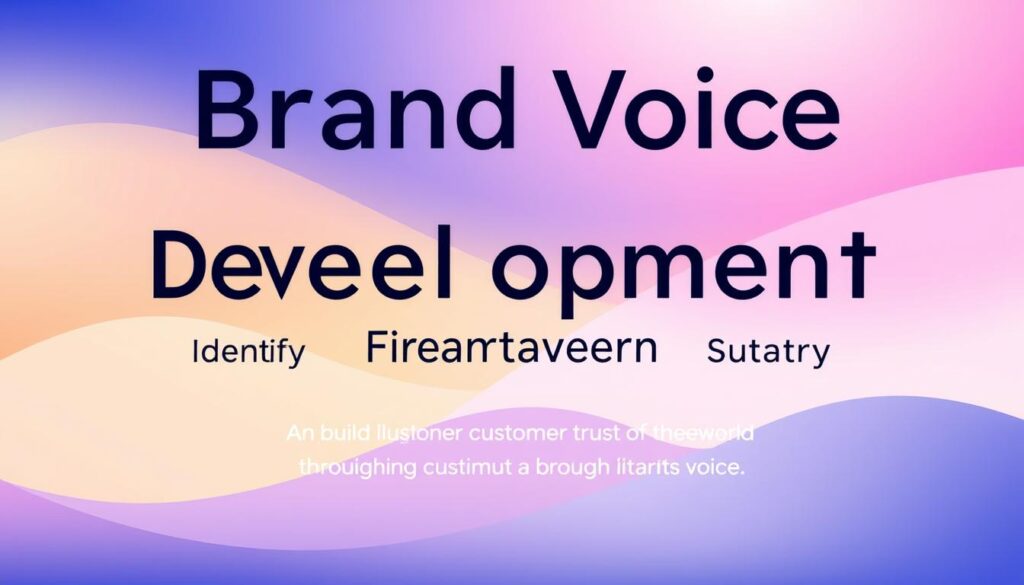How to Build Customer Trust When Everyone Sounds the Same Online
Your customers can’t tell you apart from your rivals. They check out five websites in your field, and each one promises “quality service,” “customer-first approach,” and “innovative solutions.” This generic messaging isn’t just boring—it’s actively destroying your credibility.
Matt Quick’s story shows this issue clearly. He was ready to pay for a year upfront. But the sales rep just followed their script, ignoring Matt’s specific needs. Matt ended the call right away. Why? Because scripted approaches show a business doesn’t care about solving your unique problems.
Research supports this. It shows that customers need to read multiple reviews before trusting a brand. Yet, 69% of consumers trust real recommendations over corporate speak. When you sound just like everyone else, there’s no reason for buyers to choose you.
Here’s your chance: online brand differentiation through real messaging gives you a big edge. The customer trust strategies in this guide go beyond old buzzwords. They help you build real connections that turn visitors into loyal buyers.
Key Takeaways
- Generic scripts and cookie-cutter messaging actively damage your credibility with customers who can’t tell you apart from rivals
- Customers notice right away when businesses focus on scripted sales over listening to their unique needs and challenges
- 69% of consumers trust real recommendations over corporate messaging, opening up huge opportunities for businesses willing to stand out
- The cost of blending in is more than just lost sales—it stops you from building the meaningful connections that create loyal customers
- There are systematic ways to build real credibility that any business can use, no matter its size or industry
- Digital-first markets make the sameness problem worse, making real communication more valuable than ever for standing out
1. Why Generic Messaging Destroys Customer Trust (And How to Spot It)
Generic messaging doesn’t just fail to attract customers—it actively destroys the trust you’re trying to build. When people visit your website, they see the same phrases on five other sites. This makes them question your authenticity.
Your marketing becomes background noise that customers ignore. They don’t even process your actual value.
The problem goes beyond being forgettable. When you sound like everyone else, customers think you’re like them. They assume you have the same limitations and service quality issues. This creates a barrier to trust that’s hard to overcome.
The Industry Buzzword Trap That Makes You Invisible
Terms like “industry-leading” and “innovative solutions” are everywhere. They’ve lost all meaning through overuse.
When customers see these phrases, they don’t react. Research shows their brains filter out these words. This is called semantic satiation.
Here are some overused phrases that harm your uniqueness:
- “Cutting-edge technology” (appears on 67% of tech company websites)
- “Committed to excellence” (used by 54% of service businesses)
- “Trusted partner” (found on 48% of B2B company homepages)
- “World-class service” (claimed by 43% of professional service providers)
- “Exceeding expectations” (stated by 39% of businesses across industries)
The danger is not just that these buzzwords fail to differentiate you. They make customers suspicious. Using vague superlatives instead of specific claims signals a lack of real differences.
What Your Customers Notice When They Compare You to Competitors
Customers evaluate you against others. They visit 3-5 competitor sites before buying. They look for authentic differences.
They notice if you sound like everyone else. They compare your messaging side-by-side. They want businesses that speak to their unique situations.
Matt Quick’s experience with a pest control company shows this problem. He was ready to commit but felt unheard. The sales rep focused on generic information instead of his specific needs.

- Specificity versus vagueness: Do you provide concrete details, or make general claims?
- Relevance to their situation: Does your content address their specific challenges, or offer one-size-fits-all solutions?
- Authentic voice versus corporate speak: Do you communicate like a real person, or hide behind jargon?
How to Spot It
Generic messaging costs you money. It increases customer acquisition costs and lowers conversion rates. The average ecommerce conversion rate is 1.4%, but unique messaging can double or triple that.
To spot generic marketing, ask these questions:
- Could this sentence appear on a competitor’s website without anyone noticing?
- Does this claim include specific, verifiable details, or rely on subjective superlatives?
- Would a customer reading this learn something concrete about how you work differently?
- Does this messaging address a specific customer situation, or speak in broad generalizations?
Test your homepage copy now. If you can’t answer “no” to the first question and “yes” to the last three, you’re using generic buzzwords. This is costing you customers who would trust and choose your business.
The financial impact of sounding generic goes beyond lost sales. When customers can’t tell you apart from competitors, they compare prices. This leads to price competition that erodes your profit margins and attracts price-sensitive customers with lower lifetime value.
To stand out, replace vague claims with specific, meaningful communication. Instead of saying you provide “excellent customer service,” describe your 2-hour response guarantee. Publish original research to show your expertise. Share detailed case studies to show how you solved specific customer problems.
The businesses that build lasting trust are those that sound different because they actually communicate differently. They’ve eliminated generic marketing language and replaced it with authentic, specific messaging that proves their value before customers even make contact.
2. Develop Your Distinctive Brand Voice in Four Strategic Steps
AI can now do many technical tasks, but your unique way of communicating is key. Chris Rapozo says your personal brand and network are more important than skills and knowledge. He points out that speaking, writing, and networking need a clear, consistent voice to stand out.
To develop an effective brand voice, you need a clear plan. This plan should capture your true personality and ensure everyone on your team speaks the same way. This process turns vague guidelines into clear rules that build trust with customers.

Step 1: Document Your Brand’s Core Values and Communication Personality
Your brand voice starts with knowing what you stand for. Before picking your communication style, you must know your non-negotiable principles. These principles are the base for authentic brand messaging that customers can trust.
This work stops scattered, confusing messages. When your team knows your core values, they can make decisions that keep the brand consistent.
Identify Three Non-Negotiable Business Principles
Start by writing down three business principles you won’t compromise on. These aren’t just marketing slogans. They’re the rules you live by.
Examples of non-negotiable principles include:
- “We never oversell services customers don’t need, even when it costs us revenue”
- “We provide complete pricing transparency upfront with no hidden fees”
- “We respond to every customer inquiry within 24 hours, including weekends”
- “We admit mistakes immediately and make them right at our expense”
- “We educate customers to make informed decisions, even if they choose competitors”
These principles should reflect your real business practices, not just what you wish you did. Customers will quickly notice if you don’t live up to your promises, which can destroy trust faster than generic messages.
Select Your Primary Communication Style
After knowing your core values, choose a primary brand communication style that fits your principles and audience. This style will be your default tone across all customer interactions.
| Communication Style | Best For | Key Characteristics | Avoid This Style If |
|---|---|---|---|
| Professional-Authoritative | B2B services, legal, financial | Formal language, data-driven, expertise-focused | Your audience values accessibility over formality |
| Friendly-Conversational | Consumer brands, hospitality, retail | Casual tone, relatable examples, personal pronouns | You’re in regulated industries requiring formality |
| Educational-Expert | Technology, consulting, professional services | Teaching-focused, clear explanations, problem-solving | Your customers prefer quick answers over detailed education |
| Inspirational-Motivational | Coaching, fitness, personal development | Action-oriented, empowering language, transformation-focused | Your audience is skeptical of hype and prefers facts |
Your chosen style should feel natural when talking to customers. If your written style is very different from how your team talks, you’ve made a mistake. Authenticity requires your documented voice to match your real personality.
Step 2: Create Your Brand Voice Documentation
Creating formal guidelines turns your brand voice into something your team can follow. This step in brand voice development makes sure your voice stays consistent as your business grows and new team members join.
Your guidelines should be specific but flexible. The goal is to keep your personality consistent, not to repeat scripted phrases robotically.
Build Your Unique Vocabulary List
Create three lists that define your brand communication style through word choice:
Words and phrases you always use: These unique expressions make your brand instantly recognizable. They might include industry terms you’ve redefined, metaphors that illustrate your approach, or simple phrases that reflect your values.
Words you never use: This list helps you avoid language that contradicts your brand personality or alienates your audience. It might include overused buzzwords, competitor terminology, or jargon that confuses more than it clarifies.
Industry jargon requiring translation: Document technical terms your audience encounters and provide clear explanations you’ll use consistently. This list ensures your team educates customers instead of confusing them with unexplained terms.
“Your brand voice is not what you say, but how you make people feel when they hear from you.”
Review these lists every quarter as language evolves and new terms emerge in your industry. What was fresh six months ago might now be seen as overused.
Define Tone Variations for Different Situations
Your core brand communication style stays the same, but your tone changes based on the situation. A voice consistency strategy includes documented tone variations for common scenarios your team faces.
Document specific tone adjustments for these situations:
- Announcing exciting news: More enthusiastic and celebratory while maintaining professionalism
- Addressing customer complaints: Empathetic and solution-focused without becoming defensive
- Explaining complex topics: Patient and educational without being condescending
- Discussing pricing or sales: Confident and value-focused without being pushy
- Sharing difficult information: Transparent and respectful while maintaining hope
For each scenario, provide before-and-after examples showing how your brand handles it differently than a generic competitor. These examples become training materials that help new team members learn faster.
Step 3: Test Your Voice With Real Customer Interactions
The biggest mistake in brand voice development is creating guidelines without checking if they resonate with customers. Internal approval doesn’t matter if your market doesn’t respond well.
Test your voice through real customer interactions before rolling it out company-wide. Start with low-risk channels where you can get feedback quickly and adjust as needed.
Implement these testing methods:
- A/B test email subject lines and content: Send two versions of the same message using different voice approaches and measure open rates, click-through rates, and response rates
- Analyze social media engagement: Post content using your new voice and compare engagement metrics (comments, shares, saves) to your previous baseline performance
- Conduct customer interviews: Ask 10-15 customers to review sample content and describe how it makes them feel about your brand
- Monitor customer service interactions: Have team members use your new voice guidelines during support conversations and track satisfaction scores
Pay attention to both quantitative metrics and qualitative feedback. A voice consistency strategy that boosts email open rates but confuses customers hasn’t succeeded. You’ve just traded one problem for another.
This testing phase usually takes 4-6 weeks to gather enough data. Don’t rush to implement based on limited feedback. Sustainable growth comes from decisions backed by customer feedback, not just internal enthusiasm.
Step 4: Implement Voice Consistency Across Every Touchpoint
Once you’ve tested and validated your brand voice, implement it across all touchpoints. A complete voice consistency strategy covers all the ways your business communicates with customers.
Map every customer touchpoint in your business, including:
- Website homepage, product pages, and about section
- Social media profiles and posts across all platforms
- Email marketing campaigns and automated sequences
- Customer service scripts and response templates
- Printed materials, packaging, and signage
- Sales presentations and proposal documents
- Employee email signatures and out-of-office messages
Create a phased rollout plan that focuses on high-impact touchpoints first. Your website and primary email campaigns reach more customers than internal memos, so update those channels first.
Set up a review system to catch voice inconsistencies before they reach customers. Appoint a brand voice champion who understands your guidelines and reviews all customer-facing content. This role helps prevent the gradual drift that happens when team members create content without centralized oversight.
Schedule quarterly voice audits to review a sample of content from each channel and score it against your guidelines. This audit finds areas where authentic brand messaging needs strengthening through more training or clearer guidelines.
Remember, voice consistency doesn’t mean using the same exact words everywhere. Your LinkedIn posts should sound like your customer service emails, but they’ll naturally adapt to the platform and audience. The core personality remains the same, even as the specific words change.
3. Build Customer Trust Online With Radical Transparency Practices
In a world full of perfect images, being open is your edge. While others hide, business transparency stands out. It wins customers over with loyalty.
Many think being open will show weaknesses. But it does the opposite. Sharing your inner workings and mistakes makes customers feel secure.
Being open might feel scary at first. But it turns doubters into believers faster than any ad.
Show Your Complete Business Process
Your process shows your skill in action. Hiding it makes customers worry or stay unsure.
By showing all, you teach customers about what happens after they buy. This builds confidence before they spend a dime.
Create Behind-the-Scenes Content That Educates
Behind-the-scenes content shows you’re real. It answers the question of how businesses really work.
Start by making videos of how you fulfill orders. Show how orders go from start to finish. Introduce your team, giving them names and faces.

- How you source materials or select vendors
- Your quality control procedures and standards
- The actual workspace where products are created or services delivered
- Team meetings where customer feedback shapes decisions
- The technology and tools you use to serve customers better
This approach makes you a teacher, not just a salesperson. Customers like knowing what they’re getting, which speeds up their decision.
Publish Your Pricing Logic and Cost Breakdown
Pricing openly is a powerful move. It shows you’re trustworthy, more than any discount. Research shows brand transparency boosts loyalty.
Many fear sharing prices will scare off customers or help rivals. But it does the opposite. It removes the fear of hidden costs, leading to more sales.
Make content that explains your pricing clearly:
- What factors influence your pricing decisions
- How your costs break down across materials, labor, and overhead
- Why certain services or products cost more than others
- What customers receive for their investment
- How your pricing compares to industry standards and why
You don’t need to share exact profit margins. Focus on showing the value in your pricing. This turns price into a smart investment.
Own Your Mistakes and Limitations Publicly
Being perfect doesn’t build trust—being accountable does. Customers expect mistakes. They want you to own up and fix them fast.
Being upfront about what you can’t do strengthens your bond with customers. Explain delays or services you don’t offer. Customers appreciate the honesty and make better choices.
Matt Quick’s customer service shows the power of transparency:
People tell me what they want, I ask questions based on our conversation, eventually offer the best solution(s) for their needs. No need to immediately upsell or cross-sell. THIS is how trust is built.
This approach shows that honest business practices focus on real solutions, not scripted sales. Sometimes, the best thing for a customer is less than you could sell them. Admitting this builds stronger trust than making quick profits.
Document your limits clearly online. Explain what you can’t do well, what services you’ve stopped, and why. This honesty builds trust that polished marketing can’t match.
Transform Negative Feedback Into Trust-Building Opportunities
Negative feedback scares most businesses. But it’s your chance to show your true values. How you handle criticism publicly reveals more about you than a hundred good reviews.
Every complaint is a chance to show how you handle problems. Your response either confirms their fears or proves you’re worth trusting.
Establish Your Public Response Protocol
Good customer feedback management needs a clear plan that everyone follows. Without it, responses vary, hurting trust.
Your protocol should include these key points:
- Acknowledge quickly: Respond within 24 hours to show you’re watching feedback
- Take responsibility: Own the problem without excuses or blaming customers
- Explain what happened: Give context to help others understand
- Outline your solution: Describe the steps you’re taking to fix it
- Follow up publicly: Update the thread when you’ve solved the problem
This structured approach turns complaints into proof of your dedication to customer success. People reading these exchanges see accountability in action, not empty promises.
Document How You Solved Customer Problems
Case studies of solving problems are your best marketing. They show real accountability through honest business practices, not just promises.
Write detailed stories of tough customer situations you fixed. Include what went wrong, how the customer felt, what you did to fix it, and the outcome.
Structure these stories to highlight:
- The specific issue or complaint the customer raised
- Your immediate response and investigation process
- Solutions you considered and why you chose your approach
- Resources or time you invested in making things right
- The customer’s reaction and final satisfaction level
- Changes you implemented to prevent similar issues
These stories prove your values under pressure. Anyone can promise great service when everything goes right. But showing how you handle problems proves your promises are true.
Share these case studies online, in emails, and on social media. They’re powerful proof that you stand by your promises, even when it costs you.
4. Leverage Authentic Social Proof That Differentiates You
Your customers’ voices are more powerful than any marketing message. Yet, most businesses waste this trust-building tool. They show the same generic five-star ratings and vague testimonials as their competitors.
The key to compelling social proof is specificity and context. By using social proof strategies that highlight real results and customer experiences, you stand out. This is something generic reviews can’t do.
Research shows 69% of consumers trust recommendations from people they know or recognize. Targeted social proof campaigns have conversion rates between 2.4% and 3.2%. This is much higher than the 1.4% average for typical ecommerce stores.
Collect Customer Stories With Specific Context and Results
Generic testimonials like “great product” or “excellent service” don’t help you stand out. You need customer testimonials that tell detailed stories. These should include specific challenges, solutions, and measurable outcomes.
Start by reaching out to satisfied customers and ask them to share their full journey. Focus on three key elements: the problem they faced, why they chose you, and the results they got.
These detailed stories help prospects see themselves in your customers’ experiences. When a prospect reads about someone facing the same problem and getting results, trust builds naturally. This is because the story feels relevant and believable.
Record Video Testimonials Using a Proven Question Framework
Video testimonials are much more credible than text because viewers can see and hear real customers. The visual and emotional connection creates trust that written words alone can’t achieve.
Use this proven question framework for your video testimonials:
- What specific problem were you trying to solve? – This establishes the context and helps prospects identify with the customer’s situation
- What made you choose us over other options? – This highlights your differentiation through the customer’s perspective
- What measurable results have you achieved? – This provides concrete proof of value with specific numbers or outcomes
- What would you tell someone considering our business? – This creates a direct recommendation from customer to prospect
Keep video testimonials between 60-90 seconds. Shorter videos keep attention while delivering the full story with emotional impact.
Develop Case Studies With Before-and-After Metrics
Case studies are the most detailed form of social proof. They document the full customer journey with metrics. These stories show your expertise and ability to deliver results.
Structure your case studies with clear before-and-after comparisons. For example, show how a customer increased operational efficiency by 40% or reduced monthly costs by $5,000 after using your solution.
Include specific challenges, your strategic approach, implementation details, and quantifiable outcomes. The more concrete data you provide, the more credible your case study becomes to prospects.
Curate and Display User-Generated Content Strategically
User-generated content is incredibly credible because it shows real customer experiences. Photos, social media posts, and unprompted reviews from real customers provide strong proof of your value.
Encourage customers to share their experiences by creating simple opportunities for content creation. Ask them to post photos using your products, tag your business on social media, or share their success stories on review platforms.
Display this content strategically on your website and social channels. Create dedicated sections for customer photos, embed social media feeds featuring customer posts, and highlight positive reviews on product pages where prospects make purchase decisions.
Always request permission before featuring customer content publicly. This respect for privacy strengthens relationships while ensuring you have proper rights to use their testimonials and images.
Feature Third-Party Validation That Actually Matters
Third-party validation from recognized organizations, industry experts, or strategic partners adds credibility. But it must be relevant and meaningful to your target audience.
Focus on partnerships, certifications, and endorsements that your customers actually recognize and value. A certification that sounds impressive but means nothing to your audience provides zero trust-building benefit.
Display Industry Certifications With Context
Simply displaying certification logos without explanation leaves customers confused. Most people do not understand what industry certifications mean or why they should care.
Provide clear context for every certification you display. Explain what the certification requires, what standards you met to earn it, and most importantly, what concrete benefits it provides to customers. For example, instead of just showing an ISO certification logo, explain how it ensures consistent quality standards in your production process.
Highlight Strategic Partnerships and Their Benefits
Strategic partnerships with recognized brands or industry leaders transfer credibility to your business. The key is to showcase influencer partnerships and collaborations that resonate with your specific target audience.
Pants & Socks demonstrates this strategy perfectly through partnerships with athletes like cricket player Jason Roy and boxer Nick Campbell. These partnerships provide credibility with their target demographic of sports-following men ages 18 and older.
Their creative campaign asked customers to identify logo locations on athletes’ gear during actual competitions. This engaging approach achieved remarkable conversion rates of 7-8% during campaign weeks, proving the power of relevant strategic partnerships.
When highlighting your partnerships, always explain the concrete benefits customers receive. For example, emphasize how logistics partnerships enable faster shipping, or how manufacturer relationships provide better pricing that you pass along to customers.
| Social Proof Type | Trust Impact | Average Conversion Rate | Best Use Case |
|---|---|---|---|
| Video Testimonials | Very High | 2.8-3.2% | High-consideration purchases requiring emotional connection |
| Detailed Case Studies | High | 2.5-3.0% | B2B services and complex solutions requiring proof of expertise |
| User-Generated Content | High | 2.4-2.9% | Consumer products where visual proof of use builds confidence |
| Strategic Partnerships | Medium-High | 2.2-2.6% | Brands targeting specific demographics who recognize partners |
| Generic Star Ratings | Low-Medium | 1.4-1.8% | Basic credibility when no other social proof exists |
5. Create Original Content That Proves Your Expertise
Creating unique content that shows your true expertise sets you apart. It turns you from just another vendor into the trusted authority people seek before buying. When you share valuable insights others can’t, you become the go-to person for answers.
Your content marketing strategy becomes a key trust-builder when it shows real knowledge. Generic blog posts won’t stand out, but original perspectives backed by data build strong customer relationships.
Today’s businesses that win trust don’t just make more content. They create better, more substantial content that shows they really get their industry. This takes more work upfront but pays off big as your expertise attracts better prospects.
Step 1: Publish Proprietary Research and Original Data
Original research sets you apart from competitors who just repeat what’s said. By doing customer surveys, analyzing trends, or comparing solutions, you create unique insights. These insights are yours alone.
This data becomes a valuable asset that other sites link to. Each link boosts your domain authority and search visibility. It also makes you a go-to for thought leadership content. Industry publications seek out your original research, exposing you to new audiences.
Think about the unique data your business has. Customer behavior, product comparisons, or service metrics all hold valuable insights. Sharing this data, while keeping competitive secrets safe, builds trust that generic content can’t match.
Illuminate Labs grew from 6,300 to 162,000 organic page views in a year. They did this by publishing well-researched content, not just repeating common knowledge.
Step 2: Develop Educational Resources That Solve Problems
Creating educational resources that solve real problems builds trust before sales teams even get involved. The key is to provide complete answers, not just hints. This way, readers don’t have to look elsewhere for answers.
This approach tackles why website visitors leave without converting. Incomplete information frustrates people who need full solutions. When you give complete answers, visitors stay longer, engage more, and trust you more.
Write In-Depth Guides That Solve Complete Problems
In-depth guides walk readers through entire solutions, from start to finish. Blog posts might introduce ideas, but guides give step-by-step instructions and solve problems. They also anticipate and solve obstacles.
Kath Vaughn’s success with Milk Tooth shows the power of detailed product descriptions. Instead of copying generic descriptions, she wrote from a parent’s perspective. This approach got 45% of total orders from organic search without Google ads.
Her detailed descriptions outranked competitors selling the same products. Depth and authenticity matter more than just having product pages. The same goes for guides—comprehensive content outperforms shallow content every time.
Build Free Tools, Templates, and Calculators
Interactive tools provide immediate value and show your expertise in action. ROI calculators, planning templates, and assessment tools help your audience solve problems. They also capture contact information for future marketing.
These resources show you understand customer challenges in tangible ways. A financial services company might offer a retirement calculator to show they get retirement planning. A marketing agency providing a content calendar template shows they understand organizational needs.
Free tools become shareable assets that attract backlinks and social media mentions naturally. They represent how to build expertise and trust through generosity. Giving away valuable resources shows you have knowledge worth paying for.
Step 3: Take Clear Positions on Controversial Industry Topics
Taking clear positions on controversial topics differentiates you by showing conviction and deep expertise. Playing it safe with generic advice makes you forgettable. But thoughtful contrarian perspectives make you memorable and trustworthy to those who share your view.
This doesn’t mean being controversial for attention—it means sharing what you’ve learned, even if it challenges common wisdom. Thought leadership content that takes positions needs data and real experience, not just opinions.
Best Price Nutrition shows this approach through YouTube videos reviewing products and announcing new releases. Their expert perspective, delivered weekly, drives $200-$500 in daily sales from highly qualified customers who trust their recommendations.
Identify and Debunk Common Myths in Your Field
Every industry has myths that experienced practitioners know are false. Identifying and debunking these misconceptions makes you an authority willing to challenge accepted beliefs with evidence.
Start by listing advice commonly given in your industry that your experience has proven ineffective or incomplete. Explain why this conventional wisdom persists despite being problematic. Then provide the correct approach with specific examples of better outcomes.
This myth-busting content attracts attention because it contradicts what readers have heard elsewhere. It also filters your audience—prospects who appreciate evidence-based thinking will value your expertise more after reading contrarian perspectives backed by proof.
Support Your Stance With Data and Experience
Contrarian positions only build trust when backed by compelling evidence. Combine quantitative data from your original research with qualitative stories from your experience to create persuasive arguments.
Data provides objective credibility while experience adds context that numbers can’t capture. A B2B software company might share conversion rate data proving a counterintuitive onboarding approach works better, then explain through customer stories why this method succeeds.
The combination of statistics and narrative creates content that convinces skeptics and resonates emotionally with readers. This dual appeal makes your expertise demonstration more effective than either data or stories alone could achieve.
| Content Type | Trust-Building Strength | Resource Investment | Longevity | Differentiation |
|---|---|---|---|---|
| Original Research Reports | Very High | High | 2-3 years | Excellent |
| Comprehensive Problem-Solving Guides | High | Medium-High | 1-2 years | Good |
| Interactive Tools & Calculators | High | High | 3-5 years | Excellent |
| Myth-Debunking Content | Medium-High | Medium | 1-2 years | Very Good |
| Case Studies With Data | High | Medium | 1-2 years | Good |
This comparison shows how different content types require varying investments but deliver distinct trust-building benefits. Original research and interactive tools demand more resources upfront but create stronger differentiation and longer-lasting value than shorter-form content.
Your content marketing strategy should include a mix of these formats based on your resource availability and audience preferences. Start with one high-investment piece quarterly while maintaining consistent educational resources monthly to build authority systematically over time.
6. Conclusion
Your success online depends on using trust-building action steps every day. Mix your unique brand voice with clear practices, real social proof, and fresh content. This way, you build a system of customer trust that rivals can’t match.
Begin with a strategy that fits your current abilities. If you’re good at writing, start with your brand voice. If you have happy customers, gather specific testimonials and case studies. The goal is to keep going, not to be perfect.
Building lasting customer relationships is a marathon, not a sprint. Winners show up as themselves every day, keep promises, and value real connections over quick wins. Your brand’s unique voice and openness set you apart from others.
Watch your progress through better conversion rates, higher customer value, and feedback on brand recognition. As you use these strategies, more customers will choose you because they trust you. This conversion-optimized approach lays the groundwork for long-term growth, making your business the go-to choice for others.






